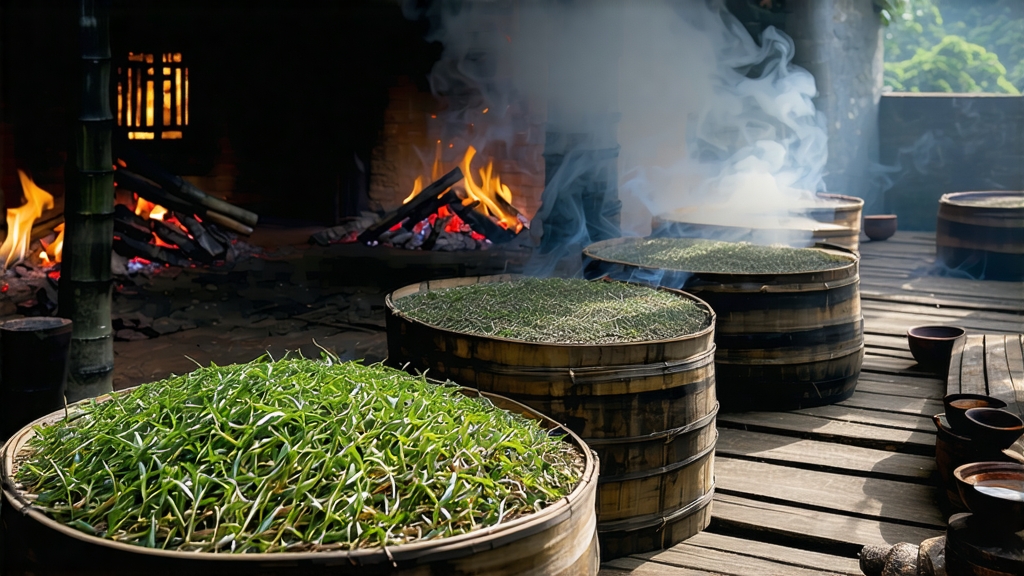
Long before Assam, Ceylon or Earl Grey entered the global lexicon, there was Lapsang Souchong—the very first black tea ever created. Born in the cool, mineral-rich folds of the Wuyi Mountains of northern Fujian, this smoke-kissed leaf altered the trajectory of world tea culture, launched a thousand clipper ships, and still refuses to be imitated convincingly outside its rocky cradle. To understand Lapsang Souchong is to hold a mirror to four centuries of maritime trade, Chinese craftsmanship, and the evolving palate of the West.
-
A history written in pine smoke
Village chronicles of Tongmu, a tiny settlement perched above the Jiuqu (Nine-Bend) Stream, place the birth of Lapsang Souchong around 1568, late in the Ming dynasty. Legend claims a passing army commandeered tea sheds during harvest season; to dry the leaves quickly before they spoiled, farmers spread them over pine fires. The resulting tea, dark, glossy and laced with resinous aroma, found unexpected favor with Dutch traders in Xiamen the following year. By 1604 the first chests reached Amsterdam, outselling the green teas that had hitherto monopolized European cups. When the British East India Company began auctioning “bohea” (the Amoy dialect rendering of “Wuyi”) in London in 1669, Lapsang Souchong—then simply called “souchong” for the small, twisted fifth leaf plucked after the prized pekoe—commanded prices higher than silver. Its smoky signature became so sought-after that 18th-century recipes for “tea punch” specified “Lapsang” by name, and Charles II’s queen, Catherine of Braganza, is said to have ended her day with a bowl scented with rosewater and Lapsang Souchong. -
Terroir: why the mountain refuses to be cloned
The Wuyi range is a UNESCO World Heritage site where 650-million-year-old igneous rock weathers into gravelly, slightly alkaline soil. Frequent mist lowers ultraviolet exposure, forcing the tea bush (here the small-leaf Camellia sinensis var. sinensis) to synthesize more amino acids and volatile oils. Night temperatures can drop 15 °C, locking in malty precursors. Crucially, the gorge is laced with Masson pine (Pinus massoniana) whose resin contains longifolene and α-terpineol—compounds that bind to leaf surfaces during smoking and create the tea’s signature cool, camphor-like finish. Attempts to replicate the process in India, Sri Lanka or even neighboring counties fail: the same cultivar grown 30 km away lacks the quartz minerality, while imported pine produces harsher, creosote-heavy notes. -
Cultivars and grades
Within Tongmu, three clonal lines dominate:- Xingcun Xiaozhong – the original small-leaf strain, giving a tight, charcoal-black strip and subtle sweetness.
- Cai Cha – a purple-stemmed hybrid developed in the 1970s, yielding larger leaves that absorb smoke more evenly.
- Jiukeng – a hardy bush planted at higher altitudes, prized for its lower yield but deeper malt.
Grading follows leaf position and finishing style. “Zhengshan Xiaozhong” (often translated “Original Mountain Small-Leaf”) is the protected-origin mark reserved for leaf picked inside the 600 km² core zone and smoked with local pine. “Wuyi Souchong” may hail from adjacent townships and is often baked rather than smoked, while “Lapsang” outside China frequently denotes generic black tea sprayed with artificial smoke flavor—an impostor instantly betrayed by its acrid, ashtray nose.
- Craft: turning green into midnight gold
Harvest takes place from late April to early May, when two leaves and a bud reach 3–4 cm. Pluckers work between 9 a.m. and 3 p.m., ensuring dew has evaporated. The leaves are withered in wooden lofts above gentle pine embers—temperature held at 28–30 °C for 8–10 hours—so that moisture drops to 60 % while smoke condenses on the leaf hairs. Rolling follows: 45 minutes of machine-assisted pressure to rupture cells, releasing catechins and enzymes. Oxidation, the step that distinguishes black from green tea, occurs in wicker